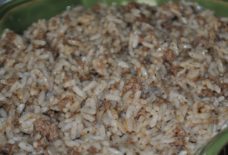The Mediterranean Diet--Middle Eastern Style
By: Blanche Shaheen/Arab America Contributing Writer
Since this pandemic began, scientific data has shown that obesity, alcoholism, depression, suicide, and a plethora of other health conditions have increased dramatically. These are all conditions that can be prevented or treated with healthy diet choices and exercise. While routines, schedules, and norms have been interrupted, health should still be the top priority to combat any illnesses. One tool in the arsenal of health is the Mediterranean diet. Interest in the Mediterranean diet began in the 1960s with the observation that coronary heart disease caused fewer deaths in Mediterranean countries, such as Greece and Italy than in the U.S. and northern Europe. Subsequent studies found that the Mediterranean diet is associated with reduced risk factors for cardiovascular disease. Because of these findings, the Mediterranean diet is one of the healthiest eating plans recommended by the Dietary Guidelines for Americans to promote health and prevent chronic disease.
But what does the Mediterranean diet look like?
The Mediterranean diet can take many forms depending on the regions bordering the Mediterranean sea. For instance, you will see different diets practiced in Italy versus Greece versus Lebanon. But there are certain diet similarities that tie all of these regions together. According to the Mayo Clinic, the main components of the Mediterranean diet include:
- Daily consumption of vegetables, fruits, whole grains, and healthy fats
- Weekly intake of fish, poultry, beans, legumes, and eggs
- Moderate portions of dairy products
- Limited intake of red meat
- Regular consumption of healthy fats from olive oil, nuts, and seeds
Other important elements of the Mediterranean diet are sharing meals with family and friends and being physically active, like taking long walks after a meal.
The Middle Eastern Interpretation of the Mediterranean Diet
While Italians enjoy their pasta, and the Greeks enjoy their variety of seafood from calamari to swordfish, the Arabs of the Levant have some different food staples that are still based on Mediterranean diet principles which are highlighted below.
FRUITS AND VEGETABLES
Fruits and vegetables include what is in season and form the foundation of the diet, with the lists below eaten most often.
VEGETABLES:
Arugula, artichokes, dandelion greens, garlic, onions, cucumbers, eggplant, jute leaves, okra, spinach, potatoes, zucchini, green beans, cabbage
FRUITS:
Mulberries, figs, stone fruits like peaches, apricots, and plums, apples, melons, citrus fruits (especially lemons), persimmons, dates, olives, avocados, tomatoes, pomegranates, grapes, carob
HEALTHY FATS:
Healthy fats are a mainstay of the Mediterranean diet. They’re eaten instead of saturated and trans fats, which contribute to heart disease. Olive oil is the primary source of added fat in the Mediterranean diet. Olive oil provides monounsaturated fat, which has been found to lower total cholesterol and low-density lipoprotein (LDL or “bad”) cholesterol levels. Arab populations also eat copious amounts of nuts and seeds as a snack or in their desserts, which also contain monounsaturated fats.
HEALTHY FAT LIST:
Olive oil, olives, ghee, avocados, nuts like almonds, pistachios, cashews, walnuts, pine nuts, sesame and pumpkin seeds
SEAFOOD
Fish is also important in the Mediterranean diet and is rich in omega-3 fatty acids, a type of polyunsaturated fat that may reduce inflammation in the body. Omega-3 fatty acids also help decrease triglycerides, reduce blood clotting, and decrease the risk of stroke and heart failure.
FISH AND SEAFOOD LIST:
Fatty fish such as mackerel, herring, sardines, tuna, salmon and trout
POULTRY, DAIRY, AND OTHER MEATS
Generally, Arab populations of the Middle East eat a lot of poultry and eggs, and reserve red meat for weekend dinners and special occasions. The favored red meat of choice is lamb, along with nose to tail organs like spleen, liver, and kidneys. Dairy is eaten in moderation in the form of feta or goat cheese to flavor salads, labneh (kefir cheese) for breakfast, and Greek yogurt as a regular side dish to rice-based dinners. Some goat’s milk cheeses are also added to desserts like Kunafeh or Katayef, but those are eaten on special occasions.
POULTRY, DAIRY, AND OTHER MEATS LIST
Chicken, cornish hens, lamb, goat, beef, spleen, kidney, tripe, liver, eggs, goat cheese, kefir cheese, feta cheese, Greek yogurt
GRAINS AND LEGUMES
What really differentiates the Middle Eastern diet from the standard Mediterranean diet is its emphasis on legumes like chickpeas for hummus, and lentils for soups and dishes like Mujaddara. Arabs favor grains like bulgur wheat, barley, wheat berries, and freekeh over pasta and other starches.
GRAIN AND LEGUMES LIST
Chickpeas, lentils, bulgur wheat, barley, wheat berries, freekeh, rice
To see a typical day of eating the Middle Eastern style of the Mediterranean diet with a sample menu, click on the video below:
Blanche Shaheen is a journalist, host of the YouTube cooking show called Feast in the Middle East, and a cookbook author. For more authentic and classical Middle Eastern recipes, you can now purchase her brand new cookbook: “Feast in the Middle East, A Personal Journey of Family and Cuisine” by clicking HERE:https://secure.mybookorders.com/Orderpage/2189
To check out her cooking video tutorials and other recipes follow Blanche on YouTube: https://www.youtube.com/user/blanchetv
Check out Arab America’s blog here!








